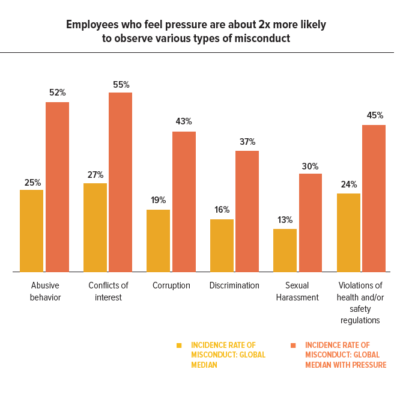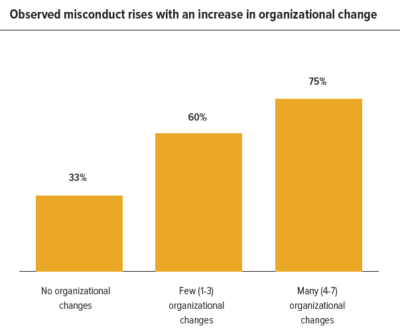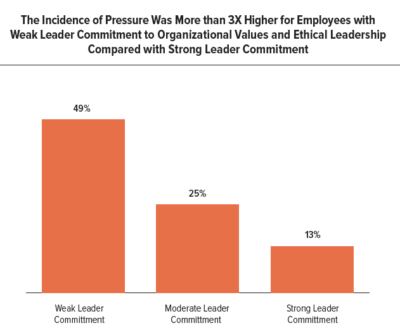In today’s organizations, employees can find themselves strapped with more responsibilities, expanding goals and tightening deadlines. When you add these factors up, it can often lead to an increase in pressure to compromise ethical and organizational values. How many of today’s employees are experiencing pressure in the workplace? What effects can it have on organizations and employees’ ability to do the right thing? Is there anything you can do to prevent the consequences of employees that feel pressure?
ECI’s first 2020 Global Business Ethics Survey ® Report, Pressure in the Workplace: Possible Risk Factors and Those at Risk tackles these questions and more, including the ways in which you can reduce pressure in the workplace. The ECI research team drilled down into data from more than 18,000 survey respondents across 18 countries to find out just how prevalent pressure is across the globe and provide a clear picture of how it is affecting workplaces.
Click here to download the full Global Business Ethics Survey Report.
Below are a few of the key findings from the report.
Pressure and Misconduct are Linked
When we talk about pressure in workplaces, we are referring to pressure to bend the rules, meaning the pressure felt by others to compromise your organization’s workplace attributes or values. According to the Global Business Ethics Survey data, “Pressure to bend the rules in the workplace can be caused by various factors, such as meeting performance goals, attempting to save one’s own and others’ jobs, supervisory pressure, advancing one’s career or financial interests, and demands from people who support or invest in the organization.”
Globally, about 22% or 1 in 5 employees feel pressure to bend the rules, with employees in South America feeling the squeeze the most (37%).
Of the biggest negative effects of pressure to workplaces is its direct link with observed incidences of misconduct. Of the 6 types of misconduct surveyed, each one was 2x more likely to be observed in organizations that are experiencing pressure.

Organizational Changes Leave Workplaces at Risk
Over time, organizational changes like mergers and acquisitions, layoffs and cost-cutting measures can affect even healthy organizations – especially during the uncertain times brought on by COVID-19. However, did you know that the more changes an organization faces, the more its employees are likely to observe misconduct?

This statistic shows a steady increase in observed misconduct when multiple factors of change affect an organization over a period of one year. The rate of organizational change was based on factors such as:
- Expanding operations into new countries/markets,
- Merging with another organization,
- Acquiring another organization,
- Being acquired by another organization,
- Experiencing changes in top management,
- Implementing layoffs, restructuring, and/or downsizing, and
- Implementing cost-cutting measures such as reductions in compensation/benefits or adjusted work schedules.
The results are staggering, with organizations facing 4 or more changes being twice as likely as organizations with no changes to experience misconduct.
Data such as this suggest that there may be a link with misconduct and the changes experienced by organizations due to the COVID-19 pandemic. Since data for this report was collected in 2019, there is no specific research on the effects of COVID-19 on organizational change and pressure. It stands to reason that when more and different types of change are experienced, such as the shift to remote work environments, there may be an effect on pressure.
Later this year, our next Global Business Ethics Survey Report will examine new data, collected during the COVID-19 pandemic, which may shed light on to the pandemics effect on workplaces.
Tone from the Top is Still Important
Ethics and compliance officers already know that this is an obvious one, and at this point, it is almost redundant to say that tone from the top matters when it comes to an organizations leaders. However, it is worth reiterating due to the huge discrepancy in how many employees feel pressure to bend the rules in organizations with weak leader commitment versus strong leader commitment. When leaders display a strong commitment to both organizational values and ethical leadership, their employees feel pressure to bend the rules more than 3 times less than when leaders show weak commitment.

How to Reduce Pressure in the Workplace
It is clear that mitigating pressure is critical in ensuring a healthy workplace culture and preventing the negative effects that occur when employees are pressured to bend the rules. Ensuring that top management remain committed to strong ethical leadership and organizational values can promote positive ethical decision making among employees and managers alike.
Questions to ask to determine why you’re employees are feeling pressure:
- Does the organization have a clear set of shared values to guide employee decisions and actions?
- Are supervisors held accountable for their mistakes?
- Do supervisors show genuine interest in their employees’ ideas/opinions?
- Do they provide feedback to their employees to help improve their work?
Use these questions to assess your ethics and compliance program and overall organization for red flags that might contribute to pressure.
Moving Forward
Armed with this knowledge, you can begin to better understand the ways in which pressure is linked with the overall health of an organization. The results of this study indicate that at its core, an organization should have an underlying commitment to organizational values and ethical leadership. Additionally, while announcing your commitment to values and ethical leadership is one step, the other should be to fully integrate this mission and communicate it to employees. Top management should be tasked with maintaining this commitment in a way that can be seen, heard and felt. This way, employees at all levels will see the actions day to day, since their direct supervisors are often the only member of the management team they interact with on a daily basis.
See more data and find out how you can decrease pressure in the workplace and decrease misconduct by reading the full 2020 Global Business Ethics Survey Report.

